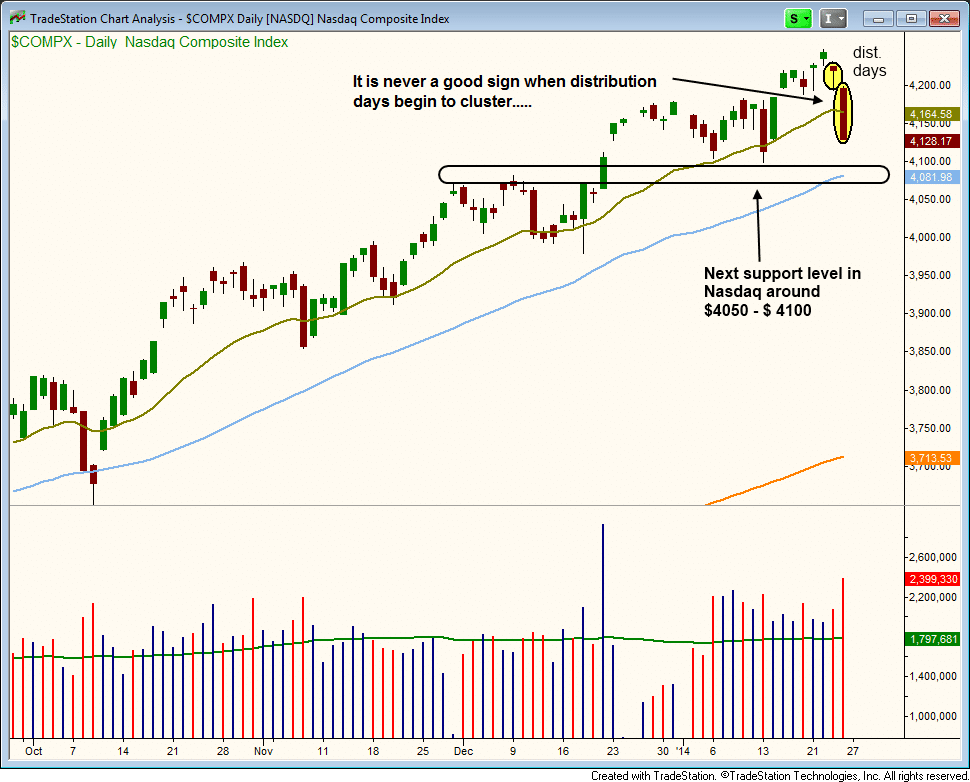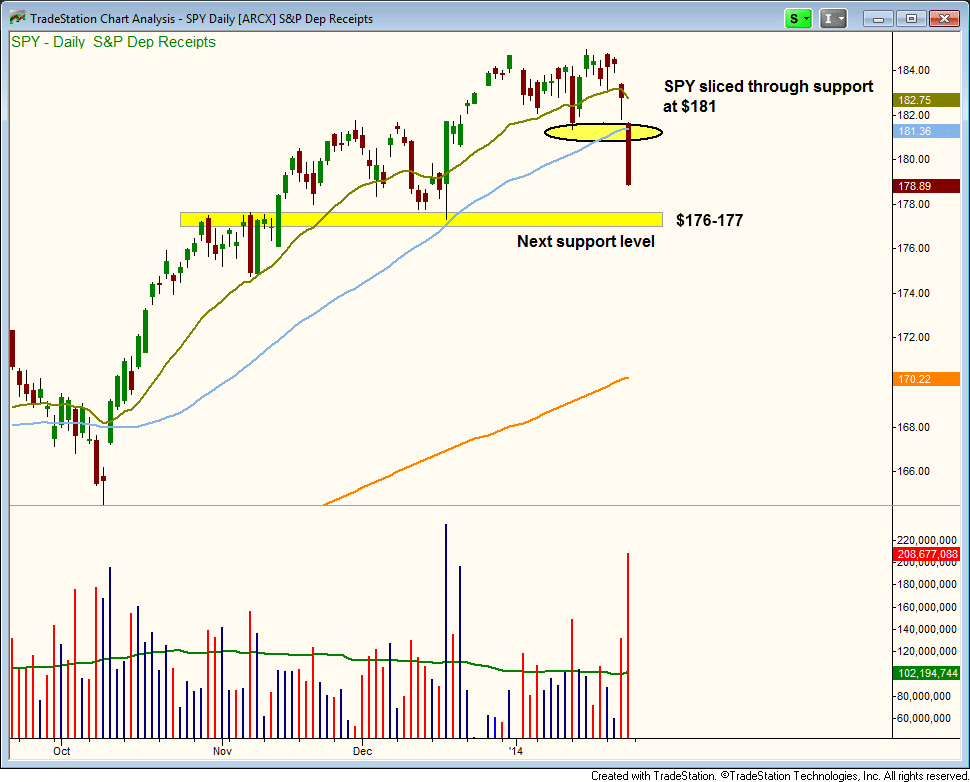 All the main stock market indexes plunged at least 2% on heavy volume on January 24, but how much did that really affect the “big picture” of the overall market trend?
All the main stock market indexes plunged at least 2% on heavy volume on January 24, but how much did that really affect the “big picture” of the overall market trend?
Trend and momentum swing traders (like me) surely gave back a chunk of unrealized gains on their winning positions (and stopped out of a few stagnant trades).
But astute traders knows that one day of price action does not change the direction of a dominant market trend.
So, what would? Let’s take an objective look at key support levels on a few charts that may help to answer that question.
NASDAQ Intact
The most negative technical aspect of the NASDAQ Composite is the back to back days of higher volume selling (“distribution days”) that formed on January 23 and 24.
While a healthy bull market can easily absorb the occasional bout of institutional selling, it’s never a good sign when distribution days begin to cluster within a brief period of time.
The heavy volume selling recently hitting the NASDAQ is shown on the daily chart below:

Despite the break of the 20-day exponential moving average (beige line) on higher turnover, the NASDAQ remains above key, intermediate-term support of its 50-day moving average (teal line).
Since pullbacks to the 50-day moving average frequently trigger computerized buying amongst institutions, it is safe to say the dominant uptrend of the NASDAQ remains intact.
Furthermore, the 50-day moving average is converging with the highs of the prior base (4,050 to 4,100 area). Convergence of support areas makes those technical support levels stronger.
In the coming week, the price of the NASDAQ could easily “undercut” the 4,050 to 4,100 area of support and bounce higher from near-term “oversold” conditions (though I think “overbought” and “oversold” are largely useless words).
S&P 500 through the 50
Although the NASDAQ uptrend may still be in effect, the chart pattern of the S&P 500 shows the benchmark US index is in much worse shape.
The ugly selloff of January 24 caused the S&P 500 SPDR ($SPY), a mainstay ETF proxy of the S&P 500 Index, to breakdown below its 50-day moving average (around $181).
The next support for $SPY is in the $176-$177 area, and is formed by the prior highs of October/November 2013, as well as the “swing low” of the December 2013 low.
If $SPY falls to that level in the coming days, you might again expect relief bounce from near-term “oversold” conditions: There is a cluster of support around $176, which is where we could expect some sort of relief bounce from short-term “oversold” conditions:

Sour, But Not Rotten
There’s no doubt that overall broad market conditions have quickly turned sour, but before turning bearish, I need to see how well the S&P and NASDAQ hold up as they test the next support levels discussed above.
I also would need to further bearish confirmation before closing all existing long positions and focusing on short selling.
If, for example, the NASDAQ Composite and Russell 2000 followed the S&P 500 below by slicing below their respective 50-day moving averages, our rule-based market timing model (learn more here) would be forced into “sell” mode.
Additionally, if most of my existing stock and ETF positions began to melt through obvious support levels, it would provide further confirmation that stocks are headed for a substantial correction (which is not to be confused with the end of a long-term uptrend).
But for now, I will definitely be avoiding new trade entries on the short side of the market (remember I am a trend trader). There will be plenty of time for low-risk short selling if/when the market eventually breaks down.
Calm, Logical Plan Of Attack
Over the next few days, I plan to hold off on establishing new positions, and simply seeing how stocks react to last week’s distribution.
Nevertheless, in the current mode of my timing model (details restricted to current newsletter subscribers), there is no concrete rule stating I can not buy an “A rated” stock on a pullback (if a low-risk entry point presents itself).
When my stock market timing system was developed, the idea was not to prevent me from being flexible. Rather, it was designed to prevent me from making costly mistakes.
For example, entering 4 to 5 new long positions while the major averages are still below their 20-period exponential moving averages on the hourly chart is dangerous.
But “dipping a toe in the water” with 1 or 2 positions (and with reduced shares) when the market begins to settle down is fine.
Overall, you need to follow a rule-based trading system, but with logical allowances for flexibility.
Not surprisingly, I surrendered some gains on my winning stock trades last Friday, but nearly all of these positions are still much higher than if I would have blindly called a top and sold my stocks for no valid reason several weeks ago.
To ensure consistent, long-term profitability as a swing and/or position trader, it’s imperative to ride the profits on your winning trades until negative price action gives you a valid reason to sell. Only now are we possibly seeing valid reason.
If you don’t want to miss our next potential “sell” signal, start your subscription to The Wagner Daily report (which includes full access to our market timing system for intermediate-term trading).
